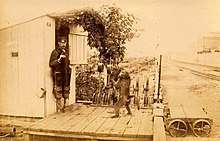Jack (baboon)
Jack (died 1890) was a chacma baboon who attained some fame for acting as an assistant to a disabled railway signalman in South Africa.[1]
 James Wide with Jack (right) | |
| Species | Baboon |
|---|---|
| Breed | Chacma baboon |
| Died | 1890 |
| Cause of death | Tuberculosis |
| Resting place | Albany Museum |
| Occupation | Assistant to a disabled railway signalman |
History
Jack was the pet and assistant of double leg amputee signalman James Wide, who worked for the Cape Town–Port Elizabeth Railway service. James "Jumper" Wide had been known for jumping between railcars until an accident where he fell and lost both of his legs.[2] To assist in performing his duties, Wide purchased the baboon named Jack in 1881, and trained him to push his wheelchair and to operate the railways signals under supervision.
An official investigation was initiated after a concerned member of the public reported that a baboon was observed changing railway signals at Uitenhage near Port Elizabeth.[3]
After initial skepticism, the railway decided to officially employ Jack once his job competency was verified. The baboon was paid twenty cents a day, and half a bottle of beer each week. It is widely reported that in his nine years of employment with the railway company, Jack never made a single mistake.[4][5]
After nine years of duty, Jack died of tuberculosis in 1890.[3] Jack's skull is in the collection of the Albany Museum in Grahamstown.
References
- Conway Morris 2003, p. 242.
- Williams, Michael (2 August 2012). "Stranger Than Fiction: Jack the Signalman". Knoxville Daily Sun. Retrieved 2014-10-27.
- Cheney & Seyfarth 2008, p. 31.
- Wallechinsky 1975, p. 697.
- "Signalman Jack: The Baboon Who Worked for the Railroad—and Never Made a Mistake". www.mentalfloss.com. 2018-10-11. Retrieved 2020-03-14.
Sources
- Cheney, Dorothy L.; Seyfarth, Robert M. (2008). The Primate Mind in Myth and Legend. University of Chicago Press. ISBN 0226102440.CS1 maint: ref=harv (link)
- Conway Morris, Simon (2003). Life's Solution: Inevitable Humans in a Lonely Universe. Cambridge University Press. p. 242. ISBN 9781139440806.CS1 maint: ref=harv (link)
- Wallechinsky, David (1975). The People's Almanac. Doubleday. p. 697. ISBN 9780385040600.CS1 maint: ref=harv (link)